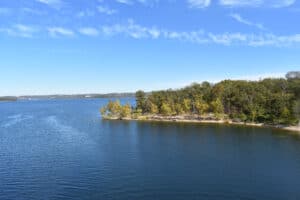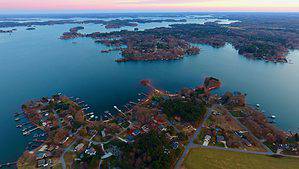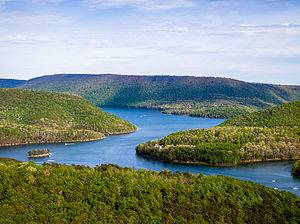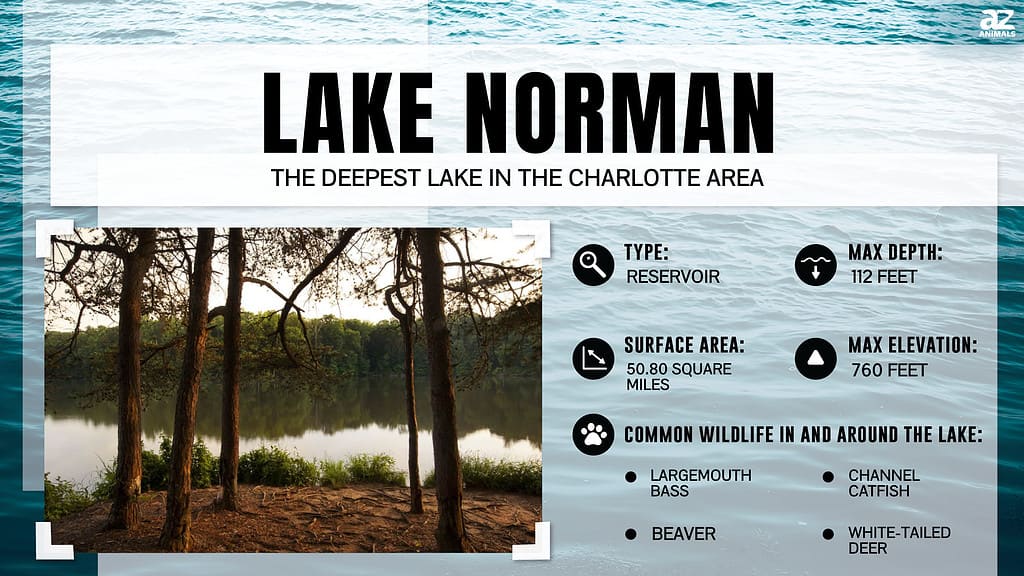
Charlotte is one of the hidden gems of the South, even if it is becoming less “hidden” these days. Although it is located firmly in the southern part of a southern state, Charlotte gets all four seasons, especially the hot summers.
During the summer, boating and “going to the lake” are essential to surviving the season south of the Mason Dixon, and few lakes are as popular in the region as Lake Norman. Today, we will be exploring this famous lake near Charlotte and officially answering the question: What is the deepest lake in the Charlotte area? Let’s get started!
The Deepest Lake in the Charlotte Area
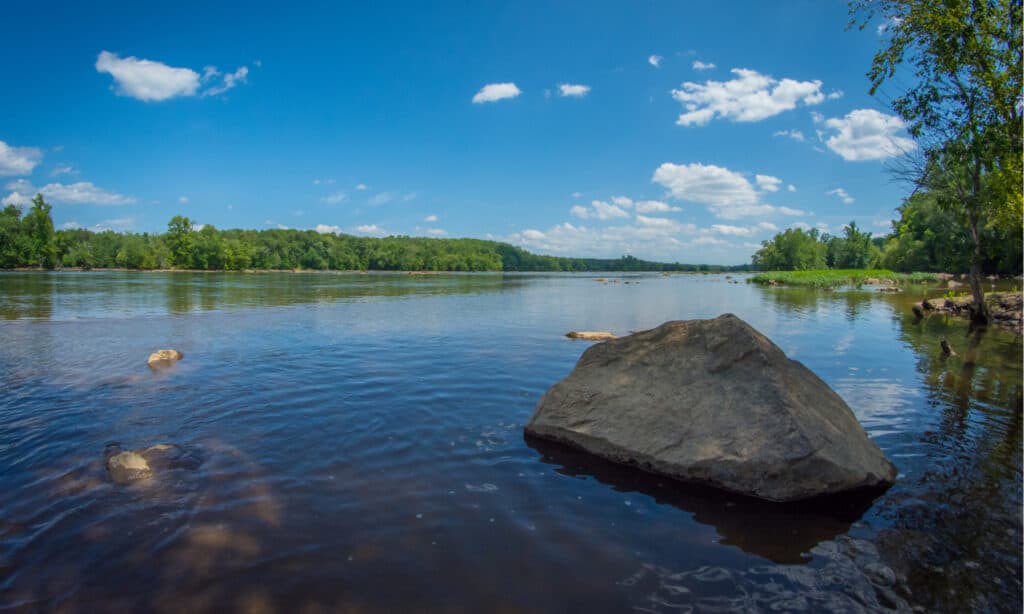
The lake was created in 1963 when Duke Energy, an electric power company, completed the construction of the Cowans Ford Dam across the Catawba River.
©John C Davis III/Shutterstock.com
There are generally three major lakes that are considered to be in the “Charlotte area,” although what you consider to be close to the city is a bit subjective. These three lakes are Lake Norman, Lake Wylie, and Mountain Island Lake. Of these three, Lake Normal is the largest, deepest, and most popular of them all. Lake Norman is the deepest lake in the Charlotte area.
Lake Norman is a lake to the north of Charlotte that is large enough to touch a few towns and cities, including Davidson, Cornelius, Denver, Sherrils Ford, and Mooresville (plus a lot more). The lake has a max depth of 112 feet and an average depth of 33.5 feet, putting it squarely ahead of both Mountian Island Lake and Lake Wylie.
In addition to being the deepest lake in the Charlotte area, it is also the largest man-made lake in the entire state. Lake Norman has a maximum length of 33.6 miles, a max width of 9 miles, and over 50 square miles of surface area. Additionally, Lake Norman has over 1.348 billion cubic meters of water contained within it, 520 miles of shoreline, and contains over 60 islands!
The History and Purpose of Lake Norman
Although Lake Normal is quite large, it isn’t actually a natural lake. Lake Norman was created by the largest power company in the region, Duke Power, in order to power the surrounding area. Incredibly, there are three separate power stations that Lake Norman supplies water to a hydroelectric station at Cowands For Dam, a coal station known as Marshall Steam Station, and the McGuire Nuclear Station.
Each of these stations produces power in a different way, showing just how much utility Lake Norman provides to the area. The Marshall Steam Station is an iconic landmark on the lake since its huge steam plume can be seen rising into the sky from almost every point on the lake.
The lake was created in 1963 when the Catawba River was dammed. The land where the lake currently occupies had been planned for decades before the Catawba was ever dammed, despite it displacing long-time residents that had lived in the region for generations. The lake was officially named after Norman Atwater Cocke, the former president of Duke Energy.
Lake Norman is also the feeder lake for another body of water in the region, Mountain Island Lake. Mountain Island Lake is much smaller than Lake Norman, but it’s also a popular destination for many of the same reasons.
The Wildlife and Ecology of Lake Norman
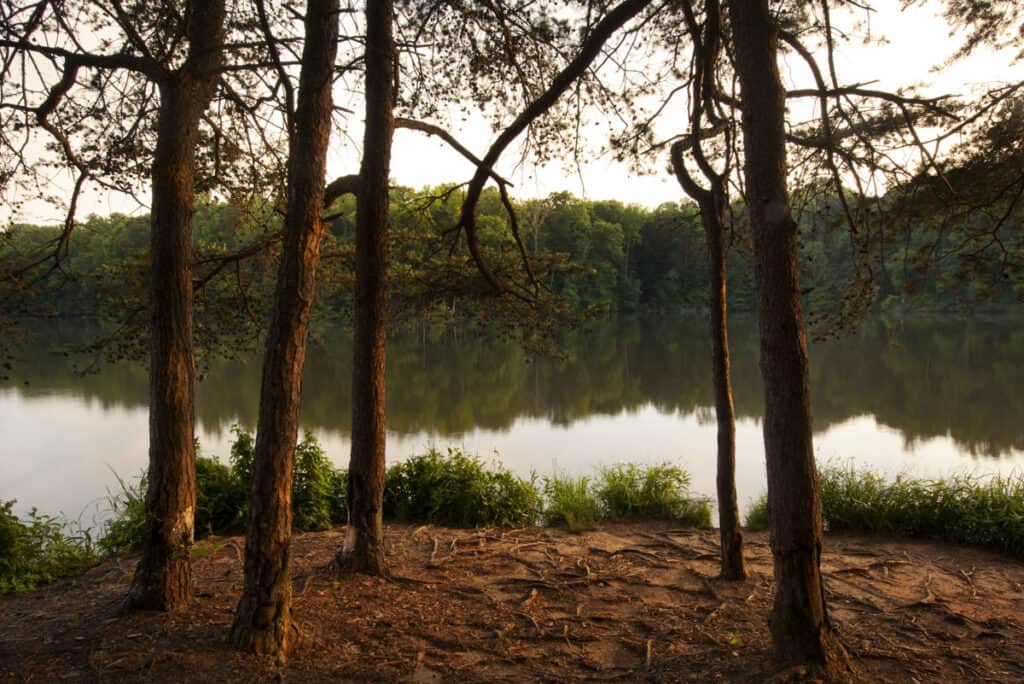
The deep depths of Lake Norman have become an attraction for divers, thrill-seekers, and scientists alike.
©iStock.com/jdwfoto
One of the defining characteristics of Lake Norman is its brown and red waters. The Piedmont of North Carolina is known for its red clay, which is ultimately caused by iron oxide.
Since the Catawba River feeds Lake Norman and carries a lot of this red iron oxide-infused clay within it, the lake reflects its location. It’s a rather well-known fact that Lake Norman appears “dirty” because of the high levels of clay in the water.
Additionally, the bottom of the lake is comprised of clay and soil that is designed to hold together when wet. For many unfamiliar with the area, stepping into the lake only to sink up to their ankles in bright red mud is an experience unique to Lake Norman!
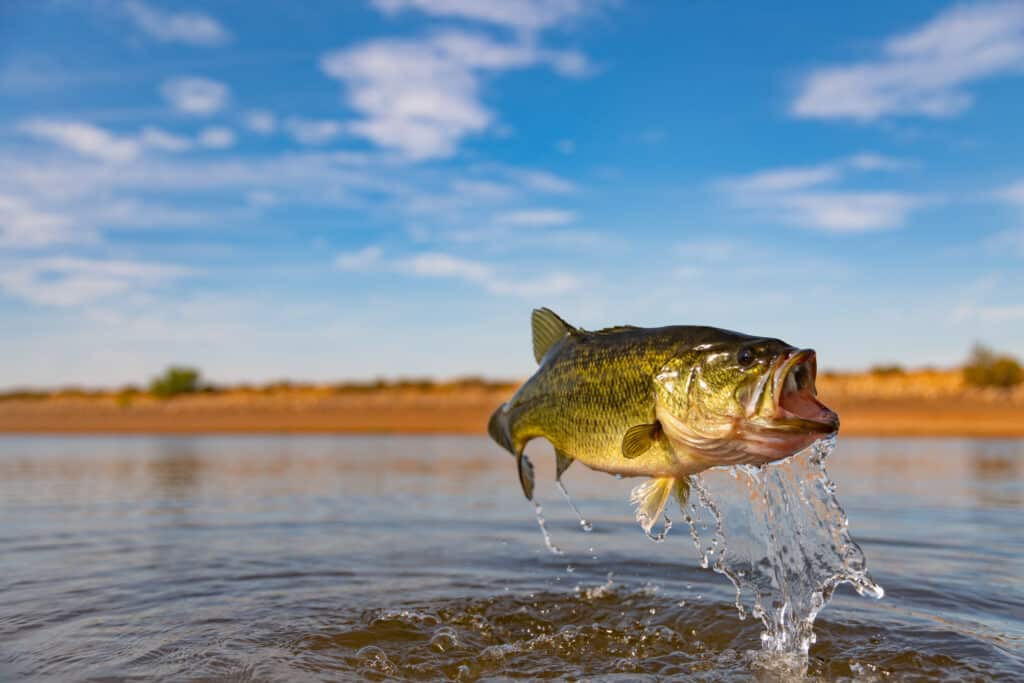
Various fish species call this lake home. One of the most prevalent among anglers is the largemouth bass.
©Ryno Botha/Shutterstock.com
Besides the mud, Lake Norman is a prime fishing location and an important natural sanctuary for a lot of local wildlife. Some of the most common fish species include:
- Black bullhead
- Blue catfish
- Bluegill
- Channel catfish
- Crappie
- Flathead catfish
- Largemouth bass
- Sauger
- Smallmouth bass
- Spotted bass
- Striped bass
- Walleye
- White bass
- Yellow perch
- Yellowfin bream
Outside of fish, other important animals include:
- Beaver
- Coyote
- Eastern cottontail
- Eastern gray squirrel
- Eastern mole
- Muskrat
- Raccoon
- Virginia opossum
- White-tailed deer
There are also around 40 species of birds that frequent the area. One of the most endangered animals within the Lake Norman ecosystem is the Carolina heel splitter, a rare freshwater mussel. Unfortunately, sediment pollution has reduced the heel splitter numbers to only a few dozen colonies.
Where Is Lake Norman Located on a Map?
The Lakeside of Charlotte refers to Lake Norman, which is situated more than 20 miles away from Charlotte and boasts 520 miles of shoreline, making it the biggest human-made lake in North Carolina.
Here it is on a map:
The photo featured at the top of this post is © KyleHohler/Shutterstock.com
FAQs (Frequently Asked Questions)
When was Lake Norman created?
The lake was created in 1963 when Duke Energy, an electric power company, completed the construction of the Cowans Ford Dam across the Catawba River. This created a body of water that stretched over 34 miles long and 9 miles wide, officially making this lake the largest man-made body of water in North Carolina.
How deep is Lake Norman?
Lake Norman is incredibly deep, with its deepest points reaching an impressive 112 feet. It has been called the “Loch Ness” of the East Coast, with numerous stories of mysterious sightings over the years.
Thank you for reading! Have some feedback for us? Contact the AZ Animals editorial team.



